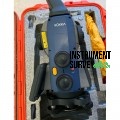 Loading... Please wait...
Loading... Please wait...- Home
- XRF Analyzer
- Thermo Scientific Niton XL3t GOLDD+ XRF Analyzer
Thermo Scientific Niton XL3t GOLDD+ XRF Analyzer
Product Description
Thermo Scientific Niton XL3t GOLDD+ XRF Analyzer
The Thermo Scientific Niton XL3t GOLDD+ XRF Analyzer is a handheld X-ray fluorescence device designed for rapid, non-destructive elemental analysis across various industries, including mining, environmental assessment, and metal recycling.
Package Includes (Typical Configuration)
-
Thermo Scientific Niton XL3t GOLDD+ Handheld XRF Analyzer
-
GOLDD+ Detector Technology for Superior Light Element Detection
-
Integrated Touchscreen Display & Trigger Operation
-
Rechargeable Lithium-Ion Battery (x2)
-
Dual-Bay Battery Charger with AC Adapter
-
Shielded Calibration Check Reference Standard
-
USB Data Cable & PC Software for Data Management
-
Rugged Carrying Case (Shock-Resistant and Weatherproof)
-
User Manual / Quick Start Guide
-
Radiation Safety & Compliance Documentation
-
Calibration Certificate
-
1-Year Manufacturer Warranty & Thermo Fisher Support








